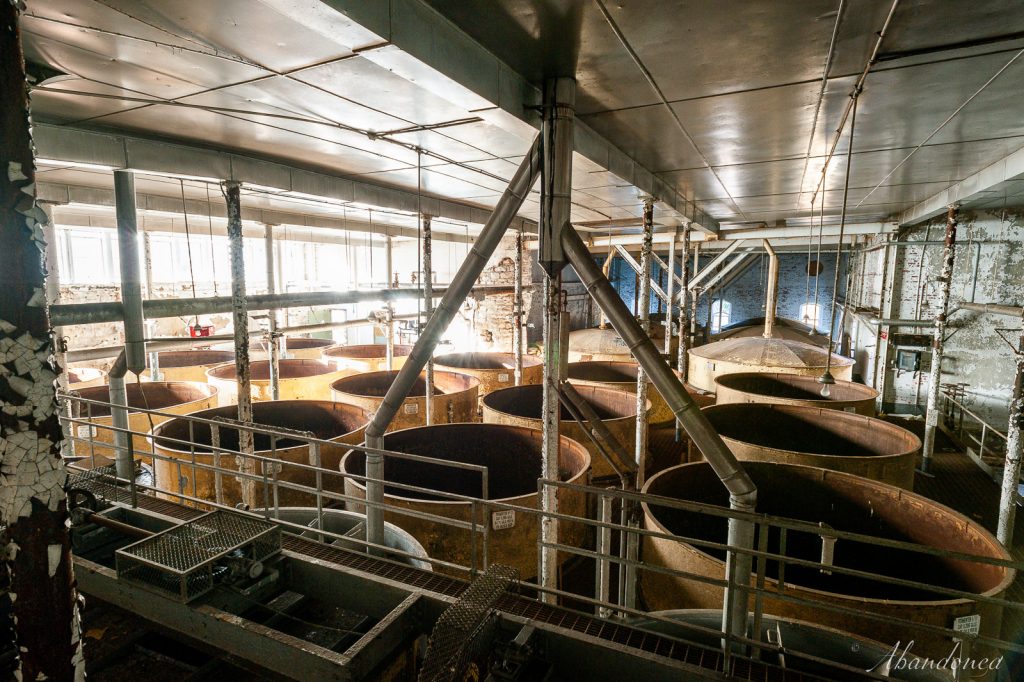Sherman Cahal and Ad…
Sherman Cahal and Adam Paris, authors of the newly released book Abandoned Kentucky, recently visited the former Old Taylor Distillery complex near Frankfort, Kentucky, to compile a series of before-and-after photos.
Colonel Edmund H. Taylor acquired property along Glenn’s Creek and Versailles Pike and established Old Taylor Distillery in 1887. It was intended to be different from the distilleries of that era which had little confidence from consumers due to product quality. From its iteration, Old Taylor was designed to be a showcase for bourbon. Drawing heavily from his travels through Scotland, England, Ireland, and elsewhere, Taylor designed his distillery complex with buildings that sported thick walls composed of local limestone from Tyrone, battlements at the roof line, and round corner towers. Inside the plant’s walls were gardens and rooms where Taylor entertained guests, state officials, and dignitaries.
The passage of prohibition, a nationwide constitutional law that strictly prohibited the production, importation, transportation, and sale of alcoholic beverages, caused Old Taylor Distillery to close in 1920. National Distillers, formed out of a merger in 1924, acquired the mothballed complex in 1935 and operated the distillery under the Old Taylor name until 1972.
In 1987, National Distillers sold the plant to American Brands, and James B. Beam Distillery, part of American Brands, used Old Taylor’s warehouses for storage. A portion of the Old Taylor campus, including the bottling plant and some warehouses, was declared surplus and abandoned. American Brands then sold the Old Taylor brand to Sazerac in 2009.
What followed was a slow decay and dismantling of the Old Taylor Distillery campus. The bottling plant was briefly repurposed for an artisan mall, but plans for a natural spring water bottling plant and a bourbon whiskey distillery never materialized. Scott Brady bought the plant in 2005 and began to tear down buildings to salvage the wood.
In 2012, Will Arvin discovered photographs of the abandoned Old Taylor Distillery. Seeing its potential, Arvin partnered with Wes Murry and acquired the facility in May 2014, and announced plans to renovate the dilapidated complex and begin distilling operations on the site. In February 2015, the company announced that Marianne Barnes would become the master distiller at the new distillery. Barnes, a former master taster at Brown-Forman and an assistant at Old Forester, became the first female master distiller since Prohibition. A new copper column still from Vendome Copper & Brass Works of Louisville was installed in October.


The company also worked with famed fine gardener Jon Carloftis to restore the historic sunken gardens.
A nod to the castle-like architecture of the buildings and the key-shaped appearance of the spring house, Arvin and Murry named the new bourbon distillery Castle & Key in February 2016. The company released its first clear spirit in April 2018, and its first aged spirit, Restoration Rye, was released in December 2020. In March 2022, the distillery released Small Batch Kentucky Straight Bourbon Whiskey, the first bourbon distillate that had been produced at the historic Old Taylor Distillery site in nearly five decades.
Colonel Taylor would have been proud to see his once-storied distillery come back to life. Buildings that were once forlorn and lifeless are once again producing the lifeblood of bourbon. On our visit, we started in the front of the complex by the scale hoppers, which were built by the Chicago Bridge & Iron Works of Chicago, Illinois in 1936.




The sweet smell from the fermenting tanks suffused the building.









The original copper column stills and other equipment were largely replaced because of deterioration.











We then entered into the gift shop that was once the boiler house that included two Erie City Iron Works boilers. Erie City Iron Works, founded in Erie, Pennsylvania in 1840 as Presque Isle Foundry, was a major producer of boilers, stationary and portable engines, and machinery.





Outside, vestiges of the past were on display. Employees rolled freshly filled barrels of bourbon down tracks to be transported by forklift to warehouses for aging. In the past, they were conveyed on conveyors, portions of which are still intact.


Afterward, it was a short walk to Warehouse B, the longest rickhouse in the world. It was once in a state of severe disrepair, but it has been put back into active operation. The scale of the building was difficult to capture, but from an aerial, one can see just how long the building is, especially in comparison to its surroundings. Because of more modern building codes for industrial buildings and proximity to the road and stream, rickhouses in this style and orientation can no longer be built.







We ended our visit at the Spring House, which is still the source of water for Castle & Key, much like how it was during the days of Colonel Taylor.


If you enjoyed this post about Old Taylor Distillery, you will enjoy similar explorations of other distilleries in the Commonwealth that can be found in our new Abandoned Kentucky pictorial book. It is available from Amazon and many other local retailers.








1 Comment
Add Yours →This was a pleasant surprise. Back in the mid-1960’s my family lived in Frankfort, and our next-door neighbour was one of the comptrollers for National with her office at the Taylor distillery. Thanks for the trip down memory lane!